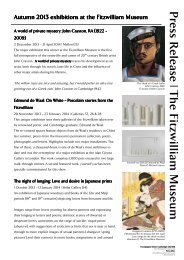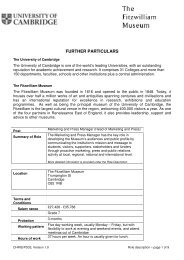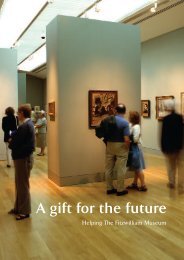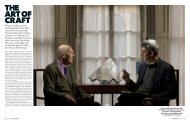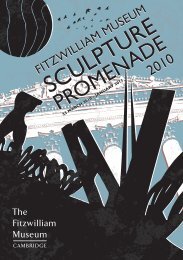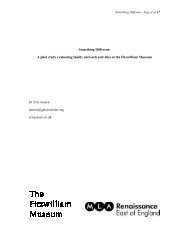The Fitzwilliam Museum - University of Cambridge
The Fitzwilliam Museum - University of Cambridge
The Fitzwilliam Museum - University of Cambridge
You also want an ePaper? Increase the reach of your titles
YUMPU automatically turns print PDFs into web optimized ePapers that Google loves.
54<br />
Major Acquisitions<br />
Ginger Jar and Cover<br />
English, London, 1673–4<br />
Maker’s mark <strong>of</strong> Jacob<br />
Bodendeich (Lüneburg<br />
1633/4–1681 London)<br />
Silver, with chased decoration<br />
H. over cover 47 cm. D. 28.5<br />
cm.<br />
Purchased from the Perceval and<br />
Cunliffe Funds with grants from<br />
<strong>The</strong> Art Fund, and the MLA/V&A<br />
Purchase Grant Fund.<br />
C.11 & A-2005<br />
This ‘ginger jar’, formerly belonged to the<br />
banker, Sir Ernest Cassel (1852–1921), a<br />
keen sportsman and art collector, whose<br />
superb collection <strong>of</strong> English silver was<br />
purchased from a descendant by a<br />
consortium <strong>of</strong> British museums in 2005.<br />
It is a handsome example <strong>of</strong> the massive<br />
ornamental silver vases which were<br />
displayed on top <strong>of</strong> cabinets and<br />
elsewhere in wealthy households during<br />
the late seventeenth century, when silver<br />
was used lavishly in furnishing. In<br />
October 1683 John Evelyn remarked on<br />
the ‘huge Vasas <strong>of</strong> wrought plate’ which<br />
he had seen in the apartment <strong>of</strong> the<br />
Duchess <strong>of</strong> Portsmouth in London (Diary)<br />
<strong>The</strong> jar chased in relief with putti amid<br />
scrolling acanthus foliage, possibly inspired<br />
by printed designs engraved by Jean Le<br />
Pautre or Polifilo Giancarli. Originally it<br />
may have had a pair, or have been part <strong>of</strong> a<br />
set <strong>of</strong> three. Its maker, Jacob Bodendeich<br />
(also known as Bodendick), was born at<br />
Lüneburg in Germany, where he served his<br />
apprenticeship between 1650 and 1654.<br />
He probably emigrated to England in the<br />
late 1650s, but although he was granted<br />
citizenship in 1661, did not become a<br />
member <strong>of</strong> the Goldsmiths’ Company<br />
until 1674. Bodendeich excelled at chasing,<br />
and was one <strong>of</strong> the most skilful and<br />
imaginative goldsmiths working in London<br />
during the 1660s and 1670s.



